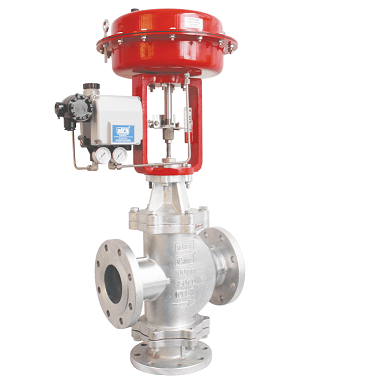As the title describes here we are going to explore all things about the Control Valve. So the first question raises that all other valves like Ball valves, Butterfly valves are not the Control Valves? Those also control the fluid and media. And the answer is YES those are the control valves but here we are going to describe a very advanced Control valve that controls the temperature, pressure, fluid level, etc. This advance valve plays a role of a backbone in many industries.
What is Control Valve?
The control valve is a Valve that allows and controls the fluid flow by varying the size of the flow passageway as signals received from the controller. It allows the direct control of flow rate that drives the control over process quantities like pressure, temperature, and liquid level.
How Control Valve work?
The control valve has a complex mechanism, it works with the help of a few external parts. First of all, we explore the main valve body.
This linear motion control valve has two ports, inlet & outlet. There is a linear motion plug used as a barrier in the valve body, that is connected with the centric stem or shaft and this shaft is connected to the diaphragm on the other end. To operate the control valve, need to energize the diaphragm. When the diaphragm goes up, the stem also lifts the plug inside the body and allows the fluid to pass through it.
There is a valve positioner fitted near the valve stem to control the opening and closing of the valve as per the direction received from the control room.
On the top, there is an actuator fitted to operate the control valve. Generally, these actuators are pneumatic, hydraulic, or electronic. There is a diaphragm connected to the centric stem Inside the actuator. When the diaphragm goes up, the plug also lifts with the help of the stem.
Operation of a Control Valve
When the operator sends the command to open or close the valve fully or partially or at any set point, the positioner decides how much the actuator has to energize to get the set point result. If there is a pneumatic actuator, then the valve positioner will decide and supply the accurate amount of pneumatic air to the actuator.
For example, if the operator sends the command to open the valve for 50%. Then the valve positioner allows that required amount of pneumatic air to the diaphragm and there is a plunger connected to the stem that will measure the current valve position.
There are two types of pneumatic actuators available: air to open and air to close. Air to open is also known as normally closed and Air to close is known as normally open.
Where to use it?
The Control Valves are used to control flow, pressure, temperature, and fluid level. In many industries required an exact point of temperature in process, in that scenario steam has been used as a heating element. The control valve shows its best performance in this condition to maintain temperature for the working process.
Conclusion
At the end of this article, we must agree that the control valves are the most intelligent and advanced valve in the valve industries. The control valve manufacturers are ready to make valves as per process need, aira euro automation is one of them. We are always ready to accept challenges in the making of modern industrial valves.
